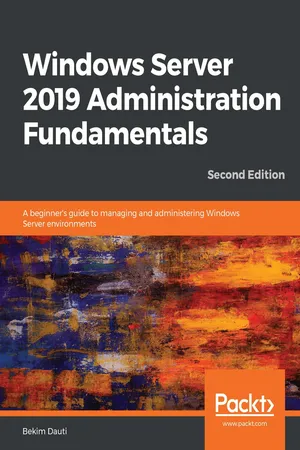
Windows Server 2019 Administration Fundamentals
A beginner's guide to managing and administering Windows Server environments, 2nd Edition
Bekim Dauti
- 426 pagine
- English
- ePUB (disponibile sull'app)
- Disponibile su iOS e Android
Windows Server 2019 Administration Fundamentals
A beginner's guide to managing and administering Windows Server environments, 2nd Edition
Bekim Dauti
Informazioni sul libro
Deploy, set up, and deliver network services with Windows Server 2019, and prepare for the MTA 98-365 exam
Key Features
- Get started with server installation, performance monitoring, and server maintenance
- Develop the skills necessary to manage an enterprise environment
- Implement networking and security best practices in your Windows Server environment
Book Description
Windows Server 2019 is the server operating system introduced by Microsoft as part of the Windows NT family of operating systems, developed concurrently with Windows 10. This book will not only get you started with Windows Server 2019, but will also help you prepare for the MTA 98-365 exam. With step-by-step instructions and easy-to-understand graphics, you will become well-versed with the roles, features, and functions of Windows Server 2019.
Starting with the installation process, upgrades, and basic configuration, you will move on to explore roles and features such as Active Directory, Hyper-V, remote access, storage, and printers. The book then takes you through maintenance and troubleshooting tasks to guide you in efficiently managing Windows Server 2019. In addition, it covers Windows Server 2019 best practices using real-world examples. Complete with questionnaires, and detailed answers at the end of the book, you can test your understanding of the concepts covered in each chapter.
By the end of this book, you will be equipped with the knowledge you need to troubleshoot, update, and maintain servers so as to ensure business continuity.
What you will learn
- Grasp the fundamentals of Windows Server 2019
- Understand how to deploy Windows Server 2019
- Discover Windows Server post-installation tasks
- Add roles to your Windows Server environment
- Apply Windows Server 2019 GPOs to your network
- Delve into virtualization and Hyper-V concepts
- Explore ways to tune, maintain, update, and troubleshoot Windows Server 2019
- Study relevant concepts in preparation for the MTA 98-365 exam
Who this book is for
If you are a system administrator or an IT professional who wants to deploy and configure Windows Server 2019, this book is for you. You can also use this as a reference guide for the MTA: Windows Server Administration Fundamentals: 98-365 exam.
Domande frequenti
Informazioni
Section 1: Introducing Windows Server and Installing Windows Server 2019
- Chapter 1, Getting Started with Windows Server
- Chapter 2, Introducing Windows Server 2019
- Chapter 3, Installing Windows Server 2019
- Chapter 4, Post-Installation Tasks in Windows Server 2019
Getting started with Windows Server
- Understanding computer networks
- Understanding servers
- Understanding Windows Server
- Chapter exercise—downloading Windows Server 2019
Technical requirements
- A PC with Windows 10 Pro, at least 16 GB of RAM, 1 TB of HDD, and access to the internet
Understanding computer networks
What is a computer network?

Types of computer networks
Personal Area Network (PAN)

LAN

MAN

WAN
